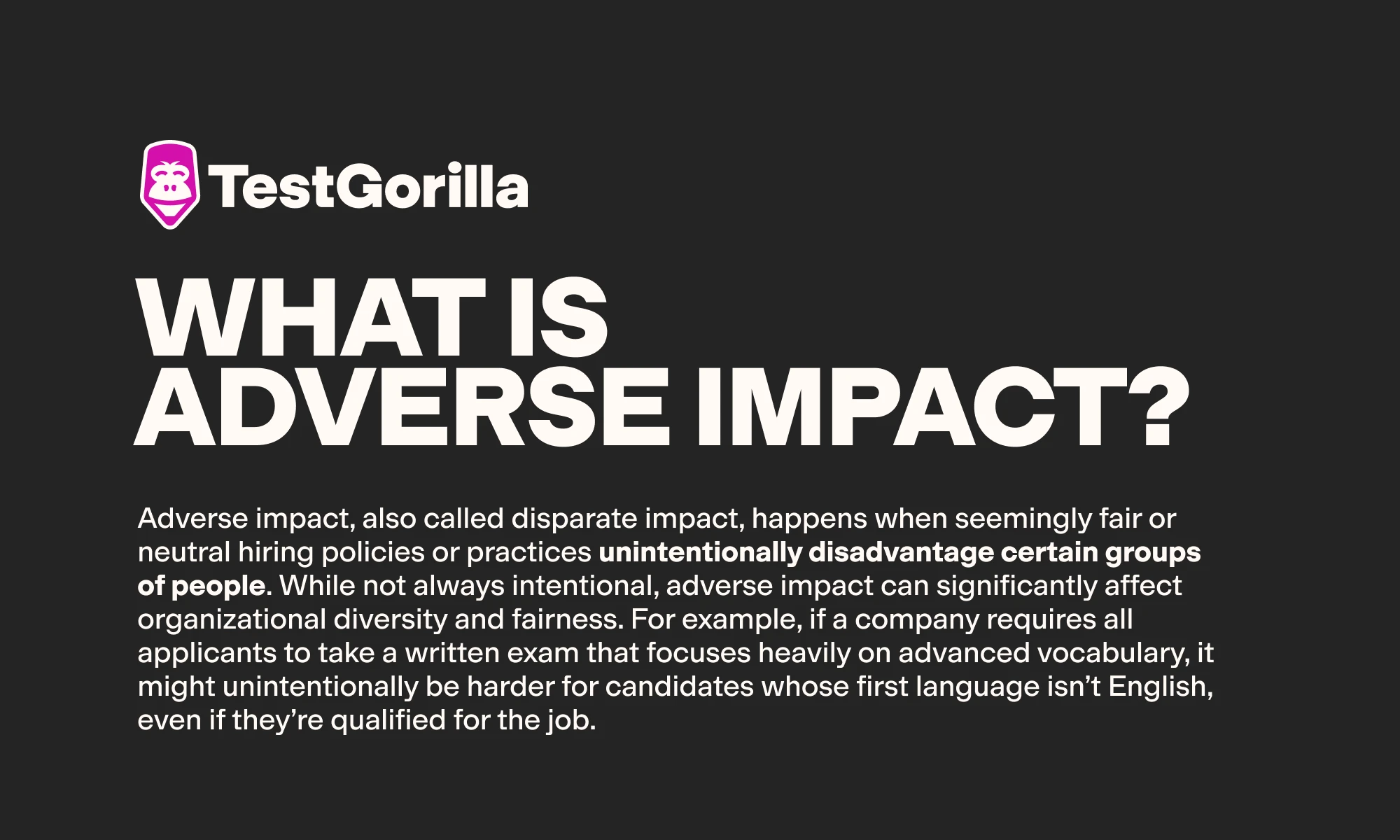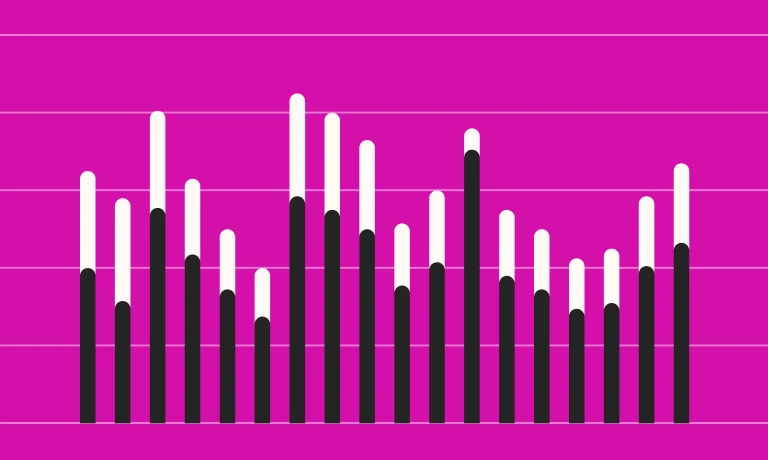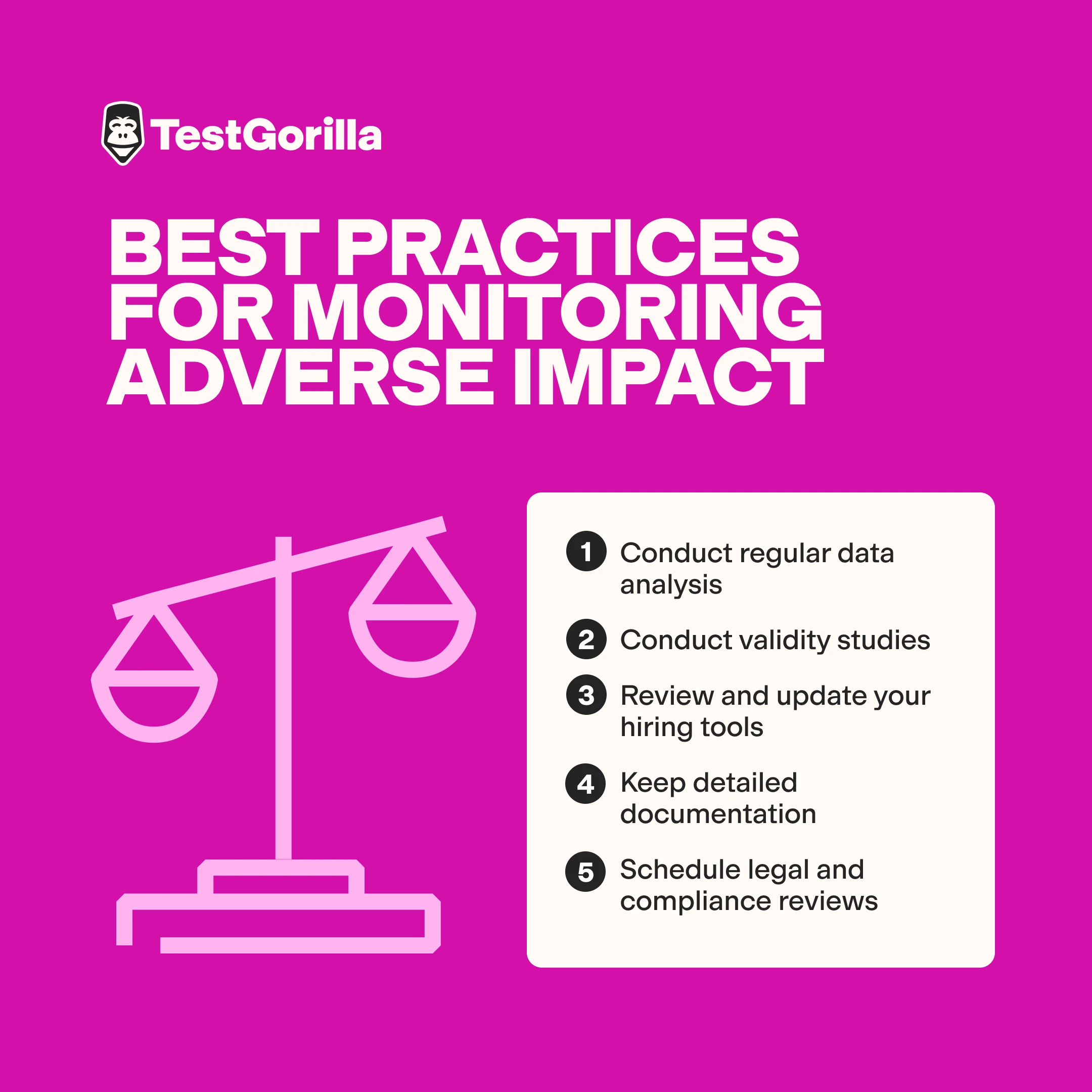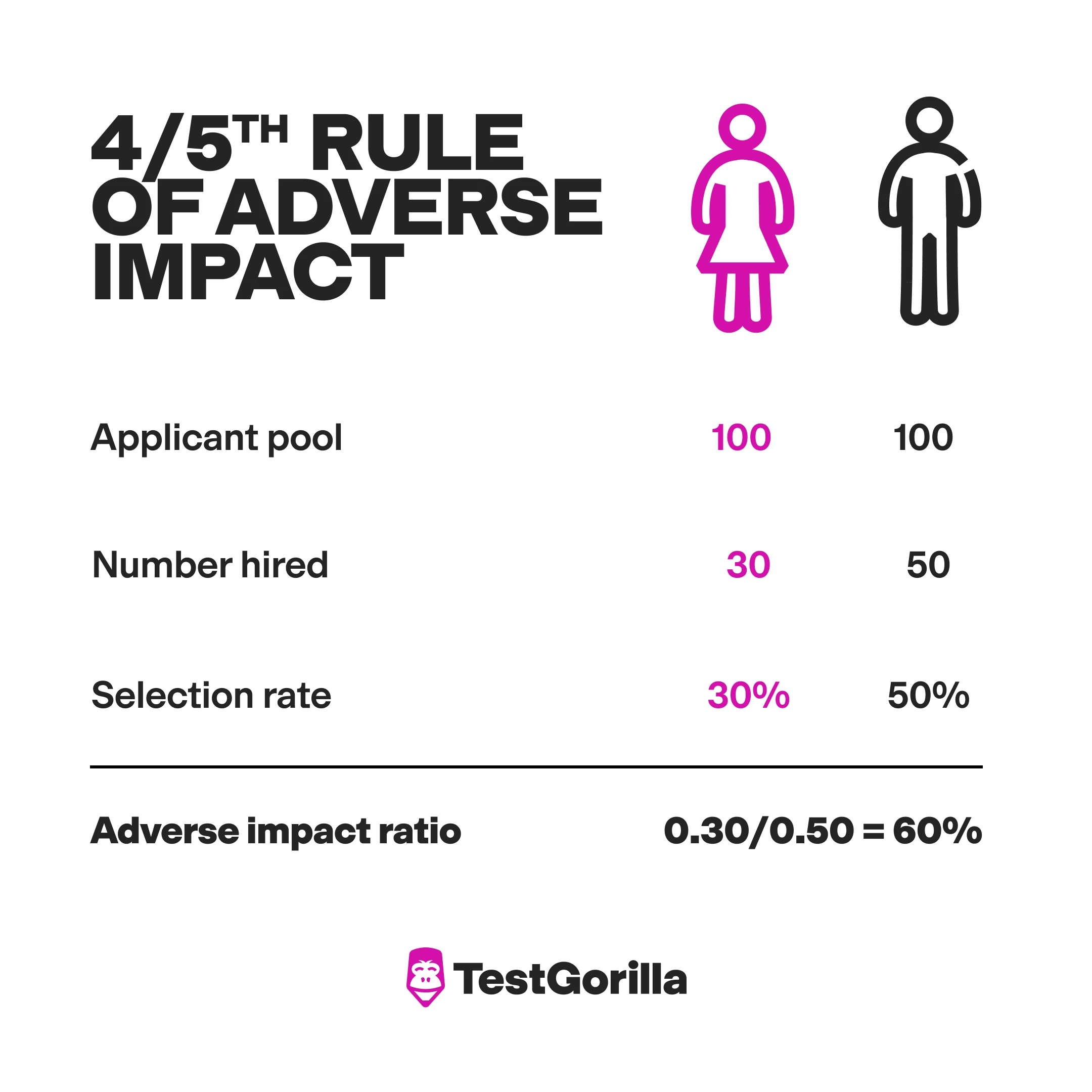Understanding adverse impact: Examples, best practices, and FAQ
Building a diverse and inclusive workplace starts with fair hiring practices. While policies may be created with the best intentions, they can occasionally lead to unintended bias, known as adverse impact. This is what occurs when certain groups are unintentionally disadvantaged in the hiring process.
By understanding how adverse impact happens, how it differs from intentional discrimination, and how to monitor and adjust for it, you can continuously improve fairness in your hiring process. In this guide, we’ll explore the basics of adverse impact, key regulations, and practical steps to help keep your hiring practices both fair and compliant with legal standards.
Note: The information contained below is provided for informational purposes only and should not be construed as legal advice on any subject matter. If you have any questions on adverse impact, please consult with a lawyer.
What is adverse impact?
Adverse impact, also called disparate impact, happens when seemingly fair or neutral hiring policies or practices unintentionally disadvantage certain groups of people.
While not always intentional, adverse impact can significantly affect organizational diversity and fairness. For example, if a company requires all applicants to take a written exam that focuses heavily on advanced vocabulary, it might unintentionally be harder for candidates whose first language isn’t English, even if they’re qualified for the job. This could result in fewer of those candidates being hired, showing how a seemingly neutral test can still impact fairness in hiring.
Despite strong anti-discrimination laws in the workplace, adverse impact is still a common issue across the world. For example, the US Equal Employment Opportunity Commission (EEOC) regularly handles thousands of employment discrimination cases each year, most of them related to racial bias.
Disparate treatment vs. Adverse impact
Understanding the difference between disparate treatment and adverse impact helps explain how discrimination can happen in hiring practices, whether it’s intentional or not. These are two types of bias that can affect the fairness of your hiring process and potentially create legal risks for your company. Here’s how they differ.
Disparate treatment happens when someone is intentionally treated unfairly in the hiring process based on race, color, sex, age, gender identity, sexual orientation, religion, disability, or country of origin. If these traits are used to make the decision of who to hire, it’s considered disparate treatment.
On the other hand, adverse impact is when an unintentional action or policy leads to the discrimination of a particular group of individuals, even if there’s no intent to discriminate. For example, a firefighter physical fitness test might disqualify more women than men, even though the test wasn’t designed to discriminate on gender.
This discrimination can be acceptable if the test is directly related to the job’s essential requirements, but not all cases of adverse impact have such a clear connection to job needs. (We’ll discuss when adverse impact is legal later on, in the section Is adverse impact illegal?)
While tests used in the hiring process can increase fairness by providing objective data on a candidate’s knowledge, skills, and abilities, any hiring process can lead to adverse impact if it’s not properly monitored or aligned with job requirements.
The US Equal Employment Opportunity Commission (EEOC) and the Uniform Guidelines on Employee Selection Procedures (UGESP)
When discussing adverse impact, it’s important to understand the legal framework that helps companies avoid discriminatory practices. The US Equal Employment Opportunity Commission (EEOC) and the Uniform Guidelines on Employee Selection Procedures (UGESP) set key standards for fair hiring and are often used as a global benchmark. By aligning with these US standards, international companies can promote fairness and improve compliance while adapting to local laws and regulations.
The EEOC is the federal agency in the US that enforces laws prohibiting workplace discrimination based on race, gender, age, disability, religion, and national origin. It ensures that employers follow fair hiring practices and investigates claims of discrimination.
In 1978, the EEOC and other agencies issued the UGESP. These are guidelines that give employers a framework for developing and using hiring tools like tests, interviews, and other criteria. The guidelines define adverse impact, describe US laws designed to prevent discrimination, and outline validation procedures for hiring practices.
They also provide steps for documentation, data analysis, and alternatives when adverse impact is found. Although the UGESP isn’t law, it serves as an important reference in US court decisions on employment discrimination.
For employers, understanding the EEOC and the UGESP is essential to staying compliant with anti-discrimination laws and prevent adverse impact in their hiring and employment practices.
The best insights on HR and recruitment, delivered to your inbox.
Biweekly updates. No spam. Unsubscribe any time.
Is adverse impact illegal?
Under US law, adverse impact is allowed if the employer can show that the practice is job-related and necessary through a thorough job analysis.
A job analysis identifies the key tasks, duties, and responsibilities of a role, along with the skills, knowledge, and abilities needed to perform those tasks. If an employer demonstrates that a hiring tool, like a test or physical requirement, is essential for the job, and that no less discriminatory alternatives exist, the adverse impact may be legally justifiable.
For example, a fire department’s physical fitness test may disqualify more women or older candidates, but it could be justifiable because firefighting requires strength, endurance, and quick physical responses, which are essential for safety. If a job analysis shows that the test is necessary, the adverse impact may be lawful.
The key is to know whether the hiring practice is valid, meaning it predicts job performance and is tied to essential job functions. Employers should also check for less discriminatory alternatives. If none exist, and the practice is job-validated, the adverse impact may be legal.
Keep reading to learn how to monitor for adverse impact, and remember to consult with a lawyer in your jurisdiction to ensure your hiring, promotion, or termination decisions are legally compliant.
Best practices for monitoring adverse impact
To help create fair employment practices and reduce the risk of adverse impact, organizations should regularly monitor and validate their hiring processes. By staying proactive, you can ensure your practices are both fair and effective.
Below are five best practices for monitoring adverse impact that focus on data collection, analysis, and compliance.
1. Conduct regular data analysis
Regularly analyzing your hiring, promotion, and termination records not only can help you spot adverse impact on protected groups, but also supports creating a fair and inclusive workplace. Methods like the 4/5ths rule from the UGESP offer a practical way to check if your processes are working as intended and help you make informed adjustments when necessary.
The 4/5ths rule suggests that adverse impact may exist if the selection rate for a particular group is less than 80% (or 4/5ths) of the rate for the group with the highest selection rate. While not a strict legal standard, it’s a useful way to flag when a hiring process might disproportionately affect certain groups.
Here’s how to use the 4/5ths rule:
1. Calculate the selection rate: Divide the number of individuals selected from a group by the total number of applicants in that group.
If 100 people applied, and 60 were hired, the selection rate is 60%.
2. Compare group selection rates: Once you have the selection rates for each group (e.g., by gender, race, age), divide the selection rate of the lower-represented group by the selection rate of the most selected group.
If the selection rate for men is 50% and the selection rate for women is 30%, you divide 30% by 50%, resulting in 60%.
3. Assess against the 4/5ths threshold: If the result is less than 80% (or 0.8), adverse impact may be present. In the example above, 60% is less than 80%, indicating a potential issue.
By regularly applying the 4/5ths rule, employers can stay ahead of any potential adverse impact. If it’s found, further investigation and adjustments to hiring procedures may be needed to ensure compliance with anti-discrimination laws.
2. Conduct validity studies
Conducting validity studies is essential for showing that a hiring tool, such as a test or interview process, is directly related to job performance. These studies help confirm that the criteria used in hiring, promotion, or other employment decisions are actually predictive of job success.
The UGESP provide a framework for these studies, outlining three main forms of validation: criterion-related, content, and construct validity. Employers should follow these guidelines to ensure their hiring practices comply with employment laws and reduce the risk of unintentionally causing adverse impact.
3. Review and update your hiring tools
Regularly reviewing and updating hiring tools is essential to making sure they stay relevant to the job requirements and minimize adverse impact. This process should start with a thorough job analysis that outlines the tasks, skills, and abilities needed for the role.
As job roles change, employers should reassess job functions and required qualifications to remove outdated or irrelevant criteria, such as unnecessary degree requirements. Each hiring tool, such as tests or interview questions, should be directly tied to essential job functions. For example, an Intermediate Math test should only be used if the job requires solving equations involving fractions, decimals, and ratios.
Employers should also use employee feedback and performance data to refine hiring criteria so they better match the actual demands of the job. After updating these tools, it’s important to test them for adverse impact using tools like the 4/5ths rule to ensure fairness.
By keeping hiring tools aligned with current job requirements, employers can avoid unnecessary barriers, reduce adverse impact, and make better hiring decisions.
4. Keep detailed documentation
Keeping detailed documentation is essential for both compliance with employment laws and gaining insights into your hiring practices.
Employers should document every part of their hiring processes, including job analyses, data reviews, validity studies, and any updates to hiring tools. This not only demonstrates the company’s commitment to fair hiring but also ensures you’re meeting legal standards If any questions or legal issues arise, having thorough records provides important proof that adverse impact has been monitored and addressed.
5. Schedule legal and compliance reviews
To keep up with changing employment laws and guidelines, employers should schedule regular reviews with legal and compliance experts. These consultations help ensure that hiring practices are up-to-date, compliant with evolving anti-discrimination regulations, and effective. Legal experts can identify potential risks, recommend adjustments, and confirm that the organization is following best practices set by agencies like the EEOC, giving you peace of mind and confidence in your processes.
Want to learn more? Check out our blog about legal compliance and skills-based hiring.
By following these best practices, organizations can proactively monitor and address adverse impact, helping to ensure employment practices are both legally compliant and aligned with business needs.
FAQ
What is adverse impact?
Adverse impact, also called disparate impact, happens when seemingly fair or neutral hiring or employment practices unintentionally disadvantage certain groups, such as those based on race, gender, age, or other protected characteristics. It is not always intentional but can have a significant effect on workplace diversity and fairness.
What is the difference between disparate treatment and adverse impact?
Disparate treatment is intentional discrimination where individuals are treated differently based on protected characteristics such as race, gender, or age. Adverse impact, on the other hand, refers to unintentional discrimination that happens when a neutral policy or practice disproportionately affects a specific group, even though there is no intent to discriminate.
Is adverse impact illegal?
Adverse impact is not always inherently illegal. It often becomes unlawful if the employment practice causing it is not directly related to job requirements. If an employer can demonstrate through a job analysis that a selection practice is necessary for the job and no less discriminatory alternatives exist, adverse impact may be legally justifiable. Remember that every situation is different, so it’s important to consult with legal experts to make sure you’re in compliance with the right laws and regulations.
Disclaimer: The information contained in this site is provided for informational purposes only and should not be construed as legal advice on any subject matter. If you have any questions on adverse impact, please consult with a lawyer. Please also familiarize yourself with the laws and regulations in your specific country and region regarding the use of pre-employment tests in selection.
You've scrolled this far
Why not try TestGorilla for free, and see what happens when you put skills first.





















